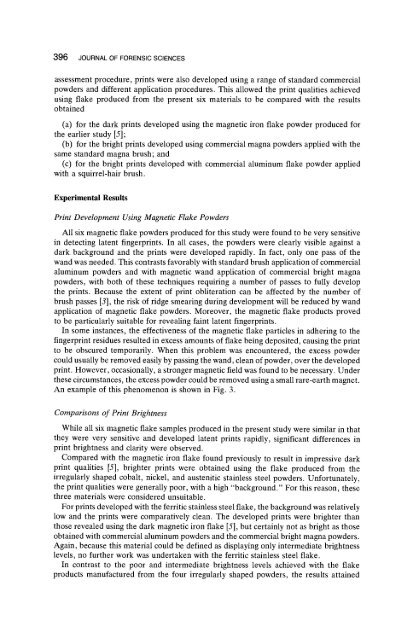Magnetic Flake Powders for Fingerprint Development - Library
Magnetic Flake Powders for Fingerprint Development - Library
Magnetic Flake Powders for Fingerprint Development - Library
You also want an ePaper? Increase the reach of your titles
YUMPU automatically turns print PDFs into web optimized ePapers that Google loves.
396 JOURNAL OF FORENSIC SCIENCES<br />
assessment procedure, prints were also developed using a range of standard commercial<br />
powders and different application procedures. This allowed the print qualities achieved<br />
using flake produced from the present six materials to be compared with the results<br />
obtained<br />
(a) <strong>for</strong> the dark prints developed using the magnetic iron flake powder produced <strong>for</strong><br />
the earlier study [5];<br />
(b) <strong>for</strong> the bright prints developed using commercial magna powders applied with the<br />
same standard magna brush; and<br />
(c) <strong>for</strong> the bright prints developed with commercial aluminum flake powder applied<br />
with a squirrel-hair brush.<br />
Experimental Results<br />
Print <strong>Development</strong> Using <strong>Magnetic</strong> <strong>Flake</strong> <strong>Powders</strong><br />
All six magnetic flake powders produced <strong>for</strong> this study were found to be very sensitive<br />
in detecting latent fingerprints. In all cases, the powders were clearly visible against a<br />
dark background and the prints were developed rapidly. In fact, only one pass of the<br />
wand was needed. This contrasts favorably with standard brush application of commercial<br />
aluminum powders and with magnetic wand application of commercial bright magna<br />
powders, with both of these techniques requiring a number of passes to fully develop<br />
the prints. Because the extent of print obliteration can be affected by the number of<br />
brush passes [3], the risk of ridge smearing during development will be reduced by wand<br />
application of magnetic flake powders. Moreover, the magnetic flake products proved<br />
to be particularly suitable <strong>for</strong> revealing faint latent fingerprints.<br />
In some instances, the effectiveness of the magnetic flake particles in adhering to the<br />
fingerprint residues resulted in excess amounts of flake being deposited, causing the print<br />
to be obscured temporarily. When this problem was encountered, the excess powder<br />
could usually be removed easily by passing the wand, clean of powder, over the developed<br />
print. However, occasionally, a stronger magnetic field was found to be necessary. Under<br />
these circumstances, the excess powder could be removed using a small rare-earth magnet.<br />
An example of this phenomenon is shown in Fig. 3.<br />
Comparisons of Print Brightness<br />
While all six magnetic flake samples produced in the present study were similar in that<br />
they were very sensitive and developed latent prints rapidly, significant differences in<br />
print brightness and clarity were observed.<br />
Compared with the magnetic iron flake found previously to result in impressive dark<br />
print qualities [5], brighter prints were obtained using the flake produced from the<br />
irregularly shaped cobalt, nickel, and austenitic stainless steel powders. Un<strong>for</strong>tunately,<br />
the print qualities were generally poor, with a high "background." For this reason, these<br />
three materials were considered unsuitable.<br />
For prints developed with the ferritic stainless steel flake, the background was relatively<br />
low and the prints were comparatively clean. The developed prints were brighter than<br />
those revealed using the dark magnetic iron flake [5], but certainly not as bright as those<br />
obtained with commercial aluminum powders and the commercial bright magna powders.<br />
Again, because this material could be defined as displaying only intermediate brightness<br />
levels, no further work was undertaken with tile ferritic stainless steel flake.<br />
In contrast to the poor and intermediate brightness levels achieved with the flake<br />
products manufactured from the four irregularly shaped powders, the results attained

















